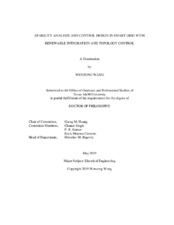| dc.contributor.advisor | Huang, Garng M | |
| dc.creator | Wang, Wenzong | |
| dc.date.accessioned | 2020-03-10T16:45:38Z | |
| dc.date.available | 2021-05-01T12:36:09Z | |
| dc.date.created | 2019-05 | |
| dc.date.issued | 2019-04-16 | |
| dc.date.submitted | May 2019 | |
| dc.identifier.uri | https://hdl.handle.net/1969.1/187529 | |
| dc.description.abstract | The increasing penetration of variable energy resources such as wind and solar is changing the dynamic characteristics of power systems. As the majority of variable energy resources are asynchronously connected to the grid through power converter based generators (CBGs), power system stability is affected significantly by this new type of generator and new stability issues are emerging. Meanwhile, the flexible operation of future power grids, especially the active transmission topology control (TTC) will introduce frequent disturbances to the system and pose threats to power system stability. With the aforementioned background, the first aim of this dissertation is to analyze the impact of CBGs and TTC on power system stability while the second aim is to design a control method for battery energy storage system (BESS) that can improve the transient stability of power systems and therefore better accommodate the variability and the flexible operation of the future smart grid. The main results of this research are listed as follows: • Based on the linearized system model, the mechanism of dynamic interaction between CBGs and synchronous generators is revealed and the conditions for strong interactions are identified. • The transient stability mechanism of CBGs is analyzed and an index to quantify the transient stability margin of CBGs is proposed. The index can be obtained analytically without running dynamic simulations.
• The impact of TTC on power system stability is investigated. Various forms of instability that can be triggered by TTC are identified and discussed. A simulation based method to assess system stability efficiently following a TTC action is proposed. • A novel wide area control method is proposed for BESSs to improve power system transient stability. The proposed control method has clear physical meanings and does not require system model or post-disturbance steady state information, which makes it suitable for future smart grid application with uncertainties and constantly changing operating conditions. | en |
| dc.format.mimetype | application/pdf | |
| dc.language.iso | en | |
| dc.subject | power system | en |
| dc.subject | stability | en |
| dc.subject | converter based generator | en |
| dc.subject | topology control | en |
| dc.subject | battery energy storage system | en |
| dc.subject | control design | en |
| dc.title | Stability Analysis and Control Design in Smart Grid with Renewable Integration and Topology Control | en |
| dc.type | Thesis | en |
| thesis.degree.department | Electrical and Computer Engineering | en |
| thesis.degree.discipline | Electrical Engineering | en |
| thesis.degree.grantor | Texas A&M University | en |
| thesis.degree.name | Doctor of Philosophy | en |
| thesis.degree.level | Doctoral | en |
| dc.contributor.committeeMember | Singh, Chanan | |
| dc.contributor.committeeMember | Kumar, P R | |
| dc.contributor.committeeMember | Moreno-Centeno, Erick | |
| dc.type.material | text | en |
| dc.date.updated | 2020-03-10T16:45:39Z | |
| local.embargo.terms | 2021-05-01 | |
| local.etdauthor.orcid | 0000-0003-2799-7122 | |


